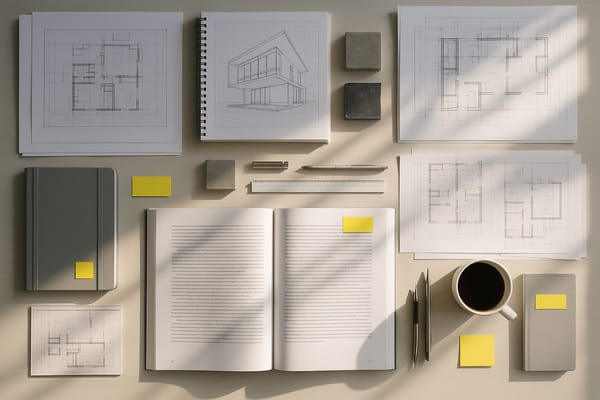Beyond the Classroom: How Actual Design Work Shapes Better Creatives
The most gifted designers didn't develop their talents just by reading books. They got there by doing the work.


Whether you're self-taught or went through design school, real-world experience is what transforms beginners into exceptional creatives.
For self-taught designers, while self-study provides crucial building blocks, it's actual design work that cements those skills. And for those emerging from design programmes, while education offers important fundamentals, only real projects can shape real-world instincts.
Once you step beyond textbooks or classrooms and start taking on professional briefs from clients, you'll quickly find that theory has its limits. Actual design projects demand practical problem-solving, technical expertise, and resilience. The complexity of real-world briefs builds abilities that formal education alone cannot provide.
By testing your talents on genuine design work, you'll hone your creative instincts, build an impressive portfolio, and gain the confidence needed for success.
So whether you're self-taught or formally educated, diving into real projects is what will take you from student to pro.
If you're eager to reach new creative heights, don't wait—start seeking out those first real clients and design challenges. Solving real problems is an education no book or classroom can replace. Get ready to level up your skills!
Learn by Doing
No amount of theory or classroom learning can replace the education you'll get from actively doing design work.
In school, you focus mainly on principles—composition, colour, typography, etc. While crucial, these fundamentals alone won't make you an exceptional designer. It's only once you start applying those skills to actual projects that your abilities truly deepen.
Real design briefs are complex and ambiguous. They require you to assess needs, solve problems, and utilise your full toolkit to conceptualise and execute solutions. With hands-on work, you'll gain practical instincts no textbook provides.
Each project will build your confidence to take on new challenges. Over time, your skills will become second nature, allowing your creativity to flourish. So seek out clients, say yes to opportunities, and start building a portfolio that shows what you can do.
The most gifted designers didn't develop their talents just by reading books. They got there by doing the work. That's how you'll reach your creative potential, too.
Immerse yourself, take risks, and let the doing transform you.
Overcome Obstacles
In school, design briefs have known parameters and solutions. But in the real world, ambiguity and unpredictability are the norm. This forces you to dig deep and build key skills.
Academic projects have defined goals, limitations, and expected outcomes. Professional briefs are often vague, with constraints and challenges emerging as you go.
With real work, you'll encounter unclear client expectations, last-minute changes, technical hurdles, and feedback that pulls you in different directions. It will push your problem-solving abilities to new levels.
Rather than get flustered, see these obstacles as opportunities for growth. Developing the resilience and resourcefulness to push through instils confidence and adaptability that will serve your whole career.
Success doesn't come from avoiding challenges but from confronting them. Keep your cool, break problems into solvable steps, and have faith that you'll find a solution. Build resilience with each obstacle you overcome, knowing you've expanded your capacities for the next project.
Real-world experience strengthens your skills in ways cloistered classroom settings cannot. Embrace the unplanned challenges that come your way.
Get Marketable Skills
As a freelancer, graphic designer, or creative professional, it's essential to have a diverse and marketable skillset. While general design classes teach broad creative principles, clients today demand specific technical and soft skills. Building a portfolio that showcases your abilities is key to getting hired or landing projects.
Here are some tips to make your skills stand out:
- Master the leading design programmes like Adobe Creative Cloud. Employers want to see expertise in Photoshop, Illustrator, InDesign, and more.
- Learn in-demand skills like UI/UX design, animation, 3D modelling, or video production. Specialising makes you more valuable.
- Hone your collaboration and communication abilities. Clients want creatives who can understand requirements, explain concepts, and work with teams.
- Showcase technical proficiency in areas like responsive design, CSS/HTML, and accessibility. These are essential for web and app projects.
- Curate an online portfolio across platforms like Behance, Dribbble, and Instagram. Demonstrate your best work across projects.
- Include client testimonials that highlight your reliability, creativity, and professionalism.
- Continuously expand your skillset by taking online courses, workshops, and certifications. Remain competitive and current.
By focusing on marketable skills and promoting them smartly, you can win more work and advance your creative career. Determine what clients in your niche need and become an expert at delivering it through your portfolio and abilities. With the right mix of technical and soft skills, you can establish yourself as a top creative talent.
Upping Your Game: Working With Real Repercussions
In school, creative projects generally have low stakes. If a design misses the mark, it’s disappointing, but everyone moves on. The real world isn’t so forgiving. When doing professional client work, mistakes can damage your reputation and the client’s business. The stakes are higher.
While nerve-wracking, higher stakes incentivise giving your best effort. Without the fire lit under you, it’s easy to procrastinate and let quality slip. The demands of professional work require you to push yourself further.
Here are some tips for upping your game when the stakes are higher:
- Take each project or client as seriously as if your career depended on it. Approach with an intense focus and sense of purpose.
- Do extensive research on the client’s needs, competitors, and target audience before starting so you understand the full context.
- Build in extra time for revisions. Prepare for multiple rounds of feedback and iterations based on client input.
- Seek guidance from more experienced professionals who understand the real-world impacts of design choices.
- Sweat the small stuff that affects execution, like colour profiles, image resolutions, file formats, etc. Don’t cut corners.
- Be transparent about struggles and ask questions early if you feel unsure, rather than covering up mistakes.
With practice, you’ll learn to thrive under pressure and do your best work when it matters most. The real-world intensity will push your skills, professionalism, and readiness for future challenges to exciting new heights.
Get Out of the Classroom and Into the Real World
The creative journey typically begins in the classroom, where students learn broad principles of design and foundational skills. This education provides an indispensable base of knowledge.
Yet, as we’ve explored, academic projects exist in a low-stakes bubble far removed from the complexity of real-world client demands. To become truly exceptional, whether you're self-taught and haven't had formal classroom education or went through design school, you need to complement your foundations with hands-on training through professional projects.
Real briefs will challenge you to get specific and technical in ways no class can teach. The stakes incentivise you to raise your game. Feedback from seasoned professionals will accelerate your growth. Most importantly, the work itself will shape your skills to meet both employers' and freelance clients'.
While nothing can replace a solid design education, at a certain point you've got to get out there, start working, and continue honing your craft in the complex reality of professional projects. Immerse yourself in real-world designing, and you’ll quickly advance from student to consummate creative professional.



